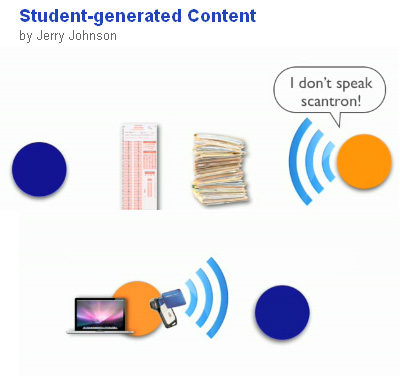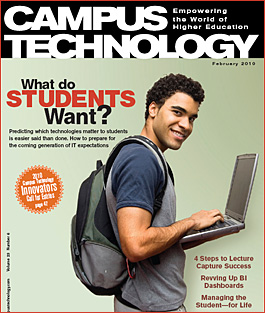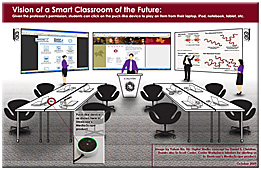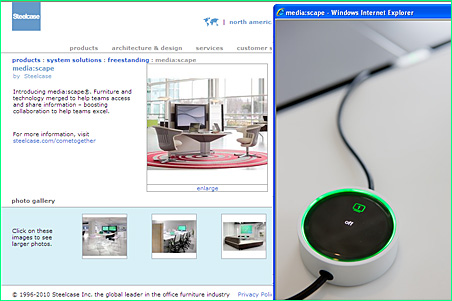Learning Styles and Tuition Dollars — from Joshua Kim; Joshua is quoted below:
Colleges and universities that invest in creating personalized learning opportunities (emphasis DSC) will gain significant advantages in the competitive market for students.
Some attributes that we will look for in selecting a college:
– A philosophy to play to the strengths of its learners as opposed to correcting their weaknesses.
– The delivery of course and learning materials in formats (and on platforms) that are flexible enough to match a range of learning styles.
– An emphasis on supporting learners in finding their passions and in transitioning to creators and leaders.
Some things that we will not consider in choosing where our tuition dollars go:
– The U.S. News & World Report rankings. Rankings are for the median student, not my student. Your school needs to be the best for my student, not for all students.
– The dorms, the grounds, the gym, etc. etc. We expect these amenities. They are not differentiators.
– The number of books in the library. Books are not scarce, and my kid can only read one at a time.
- Geo-tagging will be a powerful tool for higher education
- The Apple iPad will have a significant impact in the education market
- The “smudging” of technologies: Augmented reality, mobile computing and crowdsourcing.
- Social media can help solve the student engagement crisis.
- In order for both students and instructors to engage in social media, there needs to be a level of incentive.
Be sure to check out their GradeGuru video/piece for:
- An interesting new incentive system for students
- An engaging way to relay information
- A great illustration of the power of the web to aid in sharing educationally-related information; social learning
- A way to find other students who have good notes
From DSC:
I’ve been reflecting upon the assessment of student learning the last few days; and, in my research, I’ve seen some items that seem to point to doing things for the benefit of those administering these items. For example, I saw that one of the qualities of a good assessment is that it needs to be “easy to administer, score, and interpret”.
I understand this need to manage learning/learners/assessment, but I wonder…are we doing things for our needs and purposes of educating people? (Other examples include: Using semesters or quarters | 50 – 90 minute class periods | This class is only available on… | We offer that course only in the… | etc.)
Could we do things any differently?Are there ways to enable student learning to be fuller? Freer? More spontaneous? At their own pace?
A related reflection here:
Recently, due to so many things being on my plate, I fell behind in a class. As 2, 3, and then 4 days passed, I still hadn’t been able to get back to several of the assignments that I needed to get done. It weighed heavily on my mind…and it generated some anxiety within me. Then, I reflected on what it must feel like for students who don’t learn as fast or who need more time to get something — but, due to the way the system works — they don’t have the time or the liberty to take things at their own pace.
(No surprise to anyone reading this blog) Over time, this type of thing can lead to not only anxiety within learners, but can lead to depression and being “bumbed out” on education and learning in general. “This school thing…it’s not for me.” “I can’t keep up.” The belief that “I’m no good at this school thing!” — can lead to a serious waste of talents and abilities.
It is my hope that as we move through the next 10-20 years, education can be done in such a way that:
- Enables more control of the pacing of the learning to be turned over to the students
- Allows students to select from the media that works best for them
- Helps students identify their true passions — STEM-related or not — and then use those passions to drive learning in other areas
“The Class” – parody of The Office— from Prof Wesch
“This is from Lynn Schofield Clark’s Innovation in Mass Communications class at the University of Denver. If you are a fan of The Office, and you follow the discussions about technology use in the classroom, you will love this. They really nail the opening, and they have some great moments.”
From DSC:
Please take this in a spirit of humor. I love “The Office” and I thought this clip was a riot.
With that said, I realize that change is not easy; and again, for me, it gets back to the need for using teams to develop and deliver content. One person just can’t do it all anymore. Using the various technologies that can/will exist in a “smart classroom” is but one of many pieces involved here.
Students Sound Off on School Tech Use –– from EdWeek.org by Katie Ash and Michelle R. Davis
Discussions of technology in education typically center on what policymakers, academic experts, and educators would like to see happen in the classroom. Rarely heard are the voices of those who are actively test-driving new forms of technology: the students.
Yet the decisions schools make about technology access and use have a major impact on student engagement and learning (emphasis DSC). A 2008 survey, for instance, suggests there is growing frustration among students that they have to “power down” their use of technology when they enter school buildings. They are concerned that this reality is slowing the development of skills they’ll need to compete in a technology-driven global economy.
From Campus Technology’s latest edition — quote below from Geoff Fletcher, Editorial Director
Per Geoff: Innovation is in. Innovation has always been in, but it really is in these days: According to economists, innovation will be America’s [or substitute any nation — per DSC] hedge in an increasingly-competitive global economy, but only if our education system is good enough — is innovative enough — to foster the same creativity and inventiveness in our students.
Per DSC:
Wow…do we have our work cut out for us. From so many of the articles and postings I’ve seen over the last few years, innovation and change comes hard to those of us in the world of education. Are we giving the students the chances to be innovative and creative? Are we encouraging those traits in them? If not, what will it take to turn the tides here?
Also, I’d like to comment on students’ expectations — in that we should not underrate them! (Particularly in light of the higher costs of obtaining an education and the movement towards a more consumer-based mindset of our students.) I wonder how long will it be before prospective students take a good, long, hard look at what assistance/training/education an institution of higher education will offer them in developing their learning networks? What technologies does that institution support? What philosophies does that school have concerning how open to be here? Hmmm…
Finally, this edition sports a great article (starting on page 23) entitled, “Managing the Student for Life” — I’ve often thought that more colleges and universities should focus more heavily on lifelong learning possibilities, and then to market themselves as being able to assist a person from age 18 – until “death-do-we-part”. 🙂
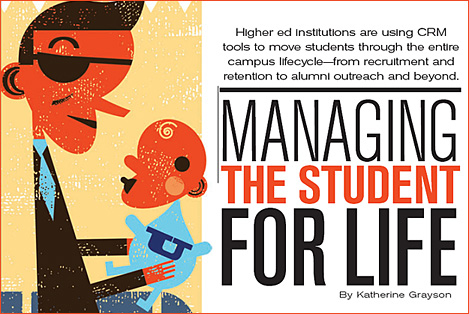
Here’s my vision of what a Smart Classroom should look like in the near future (please click on the image below to see an enlarged image and to get some further details of my thoughts here):
My thanks to Mr. Yohan Na for help with this graphic. The vision leverages the same idea as Steelcase’s Media:Scape product line:
I need to catch up to many of you out there…but while reading Kirkpatricks’ Evaluating training programs: The four levels (3rd ed.) last night, I had the following thoughts:
4 Levels:
- Reaction <– Hypothesis from DSC: K-12 and college/university students’ initial reactions will become immediately more positive if technology is used in effective, engaging ways. Start with a format/media/technique/game/simulation that interests the students the most about that topic (even if this “hook” is not going to be the focus of what you will be covering the majority of the time). For as the Kirkpatricks state on p. 22, “Positive reaction may not ensure learning, but negative reaction almost certainly reduces the possibility of its occurring” (p. 22).
- Learning
- Behavior <– In order for change to occur, four conditions are necessary:
- The person must have a desire to change
- The person must know what to do and how to do it
- The person must work in the right climate <– speaks to job families in business world
- The person must be rewarded for changing <– speaks to incentive systems. How can we build some powerful incentive systems for students? Perhaps use an online system whereby if the student successfully completes the learning objectives, they get whatever they want up to $_____ off of their tuition, or perhaps an iTunes gift certificate for K-12ers. Perhaps Apple and company would be willing to donate ___ songs or the Gates Foundation put forth $___ as a reward system here. Or perhaps if they meet ___ objectives, they earn the right to take another elective within a discipline that they are passionate about.
- Results
Kirkpatrick, D. L., & Kirkpatrick, J. D. (2005). Evaluating training programs: The four levels (3rd ed.). San Francisco: Berrett-Koehler.
My objective with this blog is to provide you with a broad-range of insights and resources regarding some tools, technologies, and strategies that help people learn and communicate. I address elements that relate to the worlds of higher education, K-12, and the corporate training/development. I seek to identify and relay patterns and trends in the quickly-changing landscapes out there, helping folks keep a pulse check on such items as:
- 1:1 computing, AI, personalized learning
- “The Forthcoming Walmart of Education”; changing business models, opportunities, and threats within the world of higher education
- The disruptive power of technology
- What elements should be in your learning ecosystem
- “Learning from the Living Room”
- Keeping students engaged
- Digital storytelling
- Multimedia (tools, techniques, trends, other)
- Mobile learning
- Building your global network
- Instructional design
- Web design and production
- …as well as other educationally-related topics.
To get an idea of my views on the above topics — along with some of the other topics I’ve covered in the last 3 years — please feel free to review my personal site at Calvin College. Here’s an example archives page covering all of 2009: http://www.calvin.edu/~dsc8/announcement_archives_2009.htm
I look forward to our future discussions as we try to make our individual and corporate contributions to the worlds of education…thereby making the entire world a better place.
Sincerely,
Daniel S. Christian









